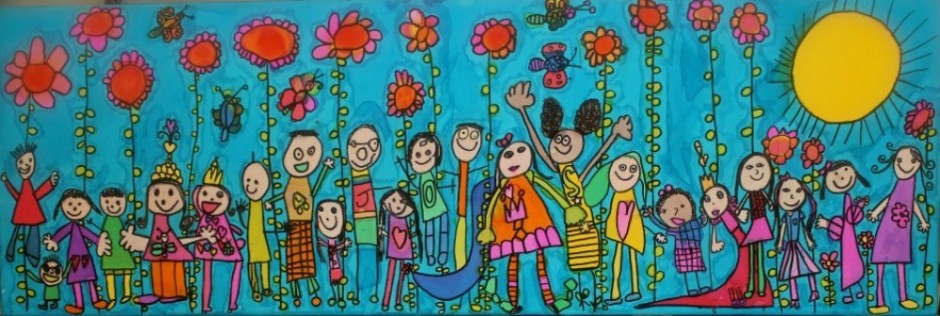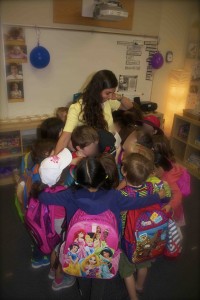
My last day of Practicum, after being surprised by an honouring party and receiving cards from both the class and parents, the students ran up to give me a final group community hug at the end of the day
When I envision my future classroom I see my student’s excited, engaged and fully immersed in the learning environment. The scene would capture the Reggio Emilia approach with a classroom environment that is inviting to both students and parents and displaying the students’ artwork and projects, documenting their explorations in a multitude of forms. The students in my class would be viewed as gifted beings that were capable of discovering, inventing and dreaming, whom I have been honoured to have in my presence.
To help you gain a sense of how I would put my philosophy into action I would like to take you on a journey to experience a few lessons and class organization that I found to be very successful during my practicum experience in a kindergarten class.
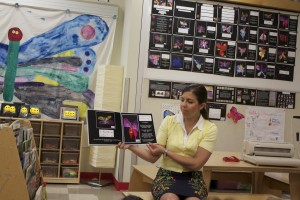
On this morning we received a package in the mail – the students were so excited, because it was the book they published and authored. The students are on the carpet, sitting extremely proud, as I read their book to them.
The bell rings and I welcome students with a genuine, warm smile and embracing demeanour excited to hear about their weekend and life outside the classroom. Noisy reading with parents takes place within the classroom, where the parents are invited in to interact with the students and allow for an easier transition from home to school. This moment also provides opportunity for me to interact with the parents, discuss their child’s artefacts displayed throughout the class and future class projects.
I sing with a soothing and inviting voice “time to put your books away” and students hug their parents and attentively sit on the carpet criss-cross applesauce in their designated spots. A check-in is done at the beginning of class to see how the students are doing emotionally and mentally as well as a quick discussion of any exciting events in their life they would like to share. This provides a deepened understanding of the overall energy of the class and helps to set the tone for the day.
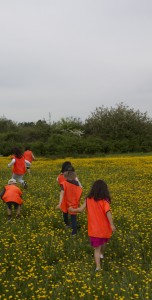
During a field trip my students indicated a need for a “wiggle break” so I incorporated a quick DPA break as a playful run through a marigold field to encourage students to expel some energy and refocus.
For example, if a majority of students were feeling quite excited and restless, a DPA break of our “kilometer run” around the track would be done earlier on in the day to allow students to feel settled and focused for classroom activities. If any particular child was having a rough morning, or perhaps there was a conflict with a few students, I would take note of it and find time to comfort the child one on one and provide the child with what they needed to feel safe and comfortable throughout the day (perhaps this was a rest break on the bench or an activity that was notably calming for that individual). Alongside comforting the student I agree with Norris’ beliefs that it is important to help students learn “to recognize emotions as they are being experienced and to [teach them] the appropriate ways of dealing with them” (Norris, 2003).
Inquiry-Based Lessons as Projects
The lessons that I would teach would have an underlying framework that would meet the needs of the diverse group of learners in my class (which during my practicum included designated E.L.L learners, students with speech deficits, sensory processing and difficulty with self-regulation).
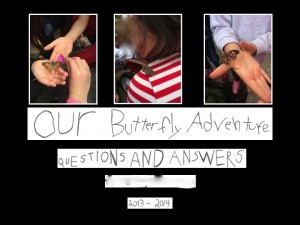
A book my class authored and published displaying their growth in understanding of our butterfly theme through collage art, questions, and answers
One project was the publication of a book on the student’s questions and answers about butterflies. The class’ exploration of butterflies began with the students expressing great interest in learning about butterflies. Familiar with Eric Carle’s book The Very Hungry Caterpillar, the students questioned how he made is art and explored his artistic technique to create their own butterflies. This project aimed to be an expression of each child’s understandings and choices to encourage pride and ownership in the work accomplished.
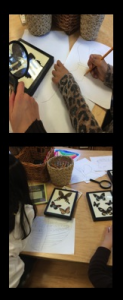
The children were then invited to look at real butterfly specimens with a magnifying glass. A butterfly drawing was then made based on the detail they saw in the specimens. These drawings became the templates used for our Eric Carle butterflies
Our butterfly exploration began by discussing questions the students had about butterflies. Their questions were then recorded and our consequent inquiry and learning was then guided by these questions. These questions were revisited and answered and new questioned were asked to deepen our learning. I state “our” learning because as the inquiry expanded I too was researching and learning new information. This is an example of working alongside my students in an exchange of knowledge and involving the students in lesson development.
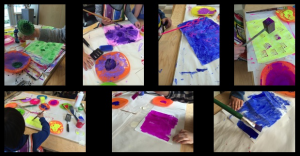
In order to make our collage butterflies we researched how Eric Carle created the colourful and textured paper. For our paper we chose to use tracing paper and tempera paints. Some students experimented by mixing colours. Each child painted a base colour of their choice onto the tracing paper and then used various tools, dipped in other colours, to paint shapes and texture
Even though spontaneity in my teaching will be fully welcomed, thoughtful planning of lessons and my assessment of students’ growth will be strongly evident to ensure that students are meeting the learning expectations. In order to maintain my role as facilitator, observer and researcher I will listen to the students thoughts and interests and “be creative and flexible in my planning to develop projects that are exciting to the students” (Fraser, 2000, p. 102).
Incorporating Adaptation
In order to accommodate a diverse classroom I would work patiently with students to adapt lesson plans. This would include rephrasing questions, using pictures to help students with understanding instructions and being patient with students’ response times. One thing I have learned through my practicum experience is that it should not be assumed that a child sitting in silence is not listening or not at the level of understanding; they may just require adaptations to help them express their knowledge.
Assessment Technique
The assessment techniques that I would use include criteria to guide students, as well as consistent feedback throughout the learning process and informal discussions with students to ensure students understood the material and were successful. A key aspect to my practicum assessment was partaking in note taking of the students behaviours/interactions with classroom peers and the creation of portfolios to allow for student self reflection.
Reflection on my Practice
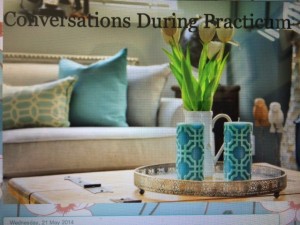
A blog created with my School Advisor as a place for us to post research, ask questions and share resources with each other to improve our lessons and classroom environment.
I believe the steps a teacher takes at the end of the day are crucial to the success of his/her students. Once the class is empty I review my anecdotal notes on my observations of the students to help me understand individual students’ needs and growth. I also prepare for the lessons for the next day and reflect on the day’s lessons of what worked really well, and where improvements can be made. As well, I bring home some notes on specific questions any students may have had that I was unable to answer at the time and set out to do my own research to further our understandings of the topics we are discussing. These actions of mine are guided by an important quote by Forest Witcraft that has guiding me through this teaching journey: “A hundred years from now it will not matter what my bank account was, the sort of house I lived in, or the kind of car I drove… but the world may be different because I was important in the life of a child.”
References:
Fraser, S. (2000). Authentic Childhood: Experiencing Reggio Emilia in the Classroom. Scarborough, Ontario, Canada: Nelson.
Norris, J. (2003). Looking at Classroom Management Through a Social and Emotional Learning Lens. Theory Into Practice , 42 (4).
